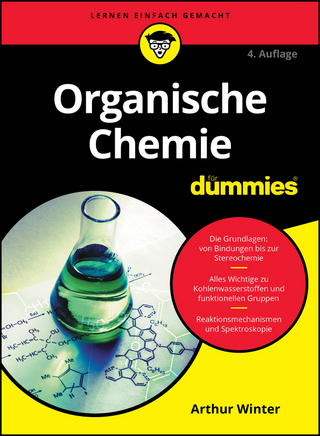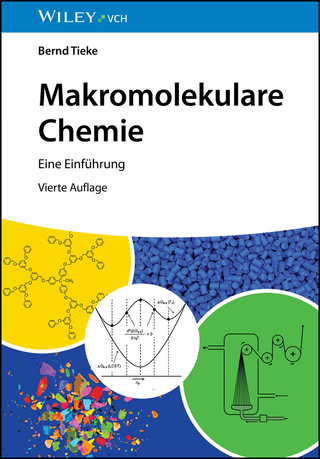
Organic Chemistry As a Second Language: First Semester Topics
John Wiley & Sons Inc (Verlag)
978-1-119-11066-8 (ISBN)
- Titel ist leider vergriffen;
keine Neuauflage - Artikel merken
David Klein is a lecturer at Johns Hopkins University where he teaches Organic and General Chemistry. He is a dynamic and creative teacher and uses analogy to help students grasp difficult topics. Klein's unique informal voice and manner of presentation help students truly master key topics in this course. He is also the author of Organic Chemistry as a Second Language; response to this book has been phenomenal.
CHAPTER 1 BOND-LINE DRAWINGS 1 1.1 How to Read Bond-Line Drawings 1 1.2 How to Draw Bond-Line Drawings 5 1.3 Mistakes to Avoid 7 1.4 More Exercises 7 1.5 Identifying Formal Charges 9 1.6 Finding Lone Pairs that are Not Drawn 13 CHAPTER 2 RESONANCE 18 2.1 What is Resonance? 18 2.2 Curved Arrows: The Tools for Drawing Resonance Structures 19 2.3 The Two Commandments 21 2.4 Drawing Good Arrows 24 2.5 Formal Charges in Resonance Structures 26 2.6 Drawing Resonance Structures Step by Step 30 2.7 Drawing Resonance Structures by Recognizing Patterns 34 2.8 Assessing the Relative Importance of Resonance Structures 43 CHAPTER 3 ACID BASE REACTIONS 49 3.1 Factor 1 What Atom is the Charge On? 50 3.2 Factor 2 Resonance 53 3.3 Factor 3 Induction 56 3.4 Factor 4 Orbitals 59 3.5 Ranking the Four Factors 60 3.6 Other Factors 63 3.7 Quantitative Measurement (pKa Values) 64 3.8 Predicting the Position of Equilibrium 65 3.9 Showing a Mechanism 66 CHAPTER 4 GEOMETRY 69 4.1 Orbitals and Hybridization States 69 4.2 Geometry 72 4.3 Lone Pairs 76 CHAPTER 5 NOMENCLATURE 77 5.1 Functional Group 78 5.2 Unsaturation 80 5.3 Naming the Parent Chain 81 5.4 Naming Substituents 84 5.5 Stereoisomerism 88 5.6 Numbering 90 5.7 Common Names 95 5.8 Going from a Name to a Structure 96 CHAPTER 6 CONFORMATIONS 97 6.1 How to Draw a Newman Projection 98 6.2 Ranking the Stability of Newman Projections 102 6.3 Drawing Chair Conformations 105 6.4 Placing Groups On the Chair 108 6.5 Ring Flipping 112 6.6 Comparing the Stability of Chairs 119 6.7 Don t Be Confused by the Nomenclature 122 CHAPTER 7 CONFIGURATIONS 123 7.1 Locating Stereocenters 123 7.2 Determining the Configuration of a Stereocenter 126 7.3 Nomenclature 134 7.4 Drawing Enantiomers 138 7.5 Diastereomers 143 7.6 Meso Compounds 144 7.7 Drawing Fischer Projections 147 7.8 Optical Activity 152 CHAPTER 8 MECHANISMS 154 8.1 Introduction to Mechanisms 154 8.2 Nucleophiles and Electrophiles 154 8.3 Basicity vs. Nucleophilicity 157 8.4 Arrow-Pushing Patterns for Ionic Mechanisms 159 8.5 Carbocation Rearrangements 164 8.6 Information Contained in a Mechanism 169 CHAPTER 9 SUBSTITUTION REACTIONS 173 9.1 The Mechanisms 173 9.2 Factor 1 The Electrophile (Substrate) 175 9.3 Factor 2 The Nucleophile 178 9.4 Factor 3 The Leaving Group 180 9.5 Factor 4 The Solvent 183 9.6 Using All Four Factors 185 9.7 Substitution Reactions Teach Us Some Important Lessons 186 CHAPTER 10 ELIMINATION REACTIONS 188 10.1 The E2 Mechanism 188 10.2 The Regiochemical Outcome of an E2 Reaction 189 10.3 The Stereochemical Outcome of an E2 Reaction 191 10.4 The E1 Mechanism 194 10.5 The Regiochemical Outcome of an E1 Reaction 195 10.6 The Stereochemical Outcome of an E1 Reaction 196 10.7 Substitution vs. Elimination 196 10.8 Determining the Function of the Reagent 197 10.9 Identifying the Mechanism(s) 199 10.10 Predicting the Products 202 CHAPTER 11 ADDITION REACTIONS 206 11.1 Terminology Describing Regiochemistry 206 11.2 Terminology Describing Stereochemistry 208 11.3 Adding H and H 216 11.4 Adding H and X, Markovnikov 219 11.5 Adding H and Br, Anti-Markovnikov 226 11.6 Adding H and OH, Markovnikov 230 11.7 Adding H and OH, Anti-Markovnikov 233 11.8 Synthesis Techniques 238 11.9 Adding Br and Br; Adding Br and OH 245 11.10 Adding OH and OH, ANTI 250 11.11 Adding OH and OH, SYN 253 11.12 Oxidative Cleavage of an Alkene 255 CHAPTER 12 ALKYNES 258 12.1 Structure and Properties of Alkynes 258 12.2 Preparation of Alkynes 261 12.3 Alkylation of Terminal Alkynes 262 12.4 Reduction of Alkynes 264 12.5 Hydration of Alkynes 268 12.6 Keto-Enol Tautomerization 273 12.7 Ozonolysis of Alkynes 278 CHAPTER 13 ALCOHOLS 280 13.1 Naming and Designating Alcohols 280 13.2 Predicting Solubility of Alcohols 281 13.3 Predicting Relative Acidity of Alcohols 283 13.4 Preparing Alcohols: A Review 286 13.5 Preparing Alcohols via Reduction 287 13.6 Preparing Alcohols via Grignard Reactions 294 13.7 Summary of Methods for Preparing Alcohols 298 13.8 Reactions of Alcohols: Substitution and Elimination 300 13.9 Reactions of Alcohols: Oxidation 303 13.10 Converting an Alcohol Into an Ether 305 CHAPTER 14 ETHERS AND EPOXIDES 308 14.1 Introduction to Ethers 308 14.2 Preparation of Ethers 310 14.3 Reactions of Ethers 313 14.4 Preparation of Epoxides 314 14.5 Ring-Opening Reactions of Epoxides 316 CHAPTER 15 SYNTHESIS 323 15.1 One-Step Syntheses 324 15.2 Multistep Syntheses 336 15.3 Retrosynthetic Analysis 337 15.4 Creating Your Own Problems 338 Answer Key 339 Index 000
| Verlagsort | New York |
|---|---|
| Sprache | englisch |
| Maße | 166 x 233 mm |
| Gewicht | 448 g |
| Themenwelt | Naturwissenschaften ► Chemie ► Organische Chemie |
| ISBN-10 | 1-119-11066-1 / 1119110661 |
| ISBN-13 | 978-1-119-11066-8 / 9781119110668 |
| Zustand | Neuware |
| Informationen gemäß Produktsicherheitsverordnung (GPSR) | |
| Haben Sie eine Frage zum Produkt? |
aus dem Bereich



